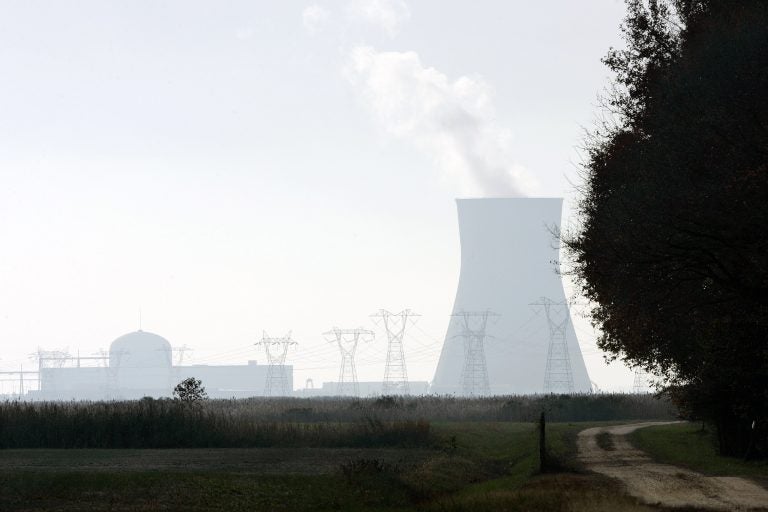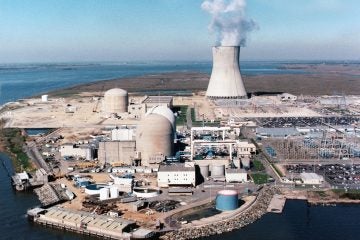Plan for underwater power line connecting Delaware to New Jersey back on
Plans to build a power line under the Delaware River may be back on the table after a decision to reconsider how the costs would be split.

A large cooling tower and other buildings at the Salem nuclear power plant known as Artificial Island can be seen near a farm in Lower Alloways Creek Township, N.J. The project calls for connecting Delaware’s electric grid to powerlines adjacent to the plant via a 230-kilovolt transmission line buried in the sediment underneath the Delaware River. (AP Photo/Mel Evans)
Plans to build a power line under the Delaware River may be back on the table after a decision to reconsider how the project’s cost would be split.
For nearly three years, the proposed power transmission line has been in limbo as leaders in Delaware and Maryland opposed the proposal to pay for the upgrades. That opposition centered on the fact that while the project would mainly benefit New Jersey, the bulk of the $278 million cost would be shouldered by ratepayers in Delaware and Maryland.
Delaware Gov. John Carney joined Maryland Gov. Larry Hogan in calling for the project to be halted.
Last week, the Federal Energy Regulatory Commission agreed to reconsider the cost allocation, calling it “unjust and unreasonable.”
“As we have said all along, that is a bad deal for the residents of our states,” Carney and Hogan wrote in a joint statement. The previous plan would have put more than 90 percent of the project’s cost on ratepayers in their states. “We are not opposed to the Artificial Island project itself, but object to unfair and unreasonable costs for our residents and businesses.”
The FERC decision calls for a new hearing on cost distribution within two months.
If all sides agree to a new plan, the project could begin in the fall.
The project director for Silver Run Electric, which is doing the construction, is confident the new hearing won’t mean more delays.
“The order that FERC issued is very structured and looks to two or three different [cost allocation] alternatives that have already been identified,” said Casey Carroll. “What they’re requesting responses on are the merits of those three alternatives, so it really didn’t open Pandora’s box, which I am very satisfied with.”
Despite the delay, Carroll said, the project is mainly unchanged and should be on target for a 2020 completion. “We certainly don’t have a lot of time to spare, but we’re confident that we’ll be able to keep things moving forward and actually be able to start construction before the end of this year,” he said.
The project, initially approved in 2015, would connect Delaware’s electric grid to powerlines adjacent to the Salem and Hope Creek nuclear plants in New Jersey via a 230-kilovolt transmission line buried in the sediment underneath the Delaware River.
WHYY is your source for fact-based, in-depth journalism and information. As a nonprofit organization, we rely on financial support from readers like you. Please give today.





